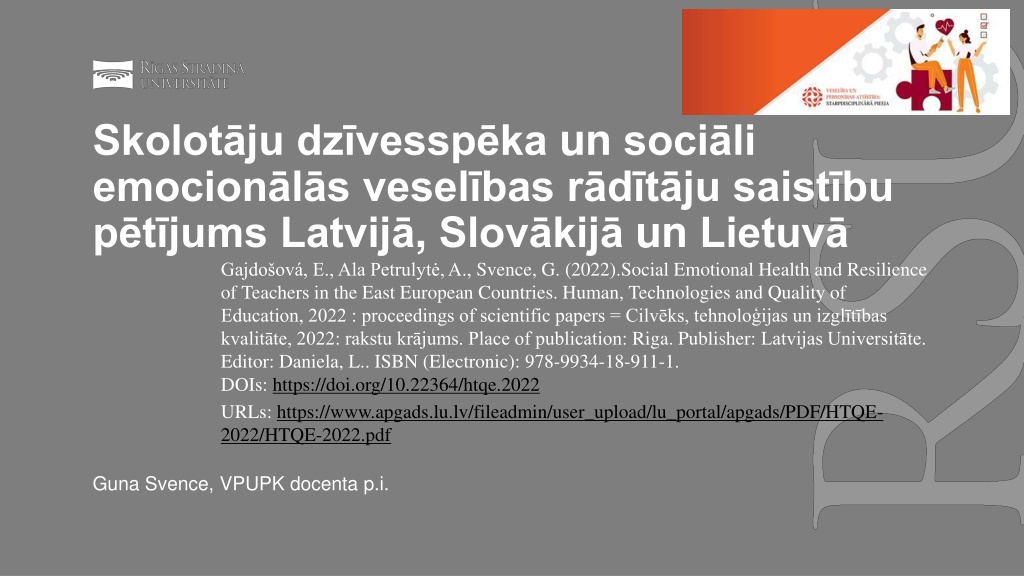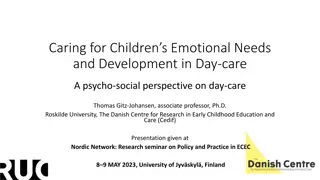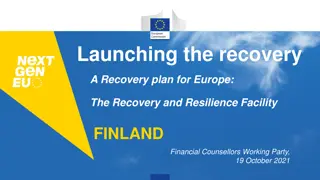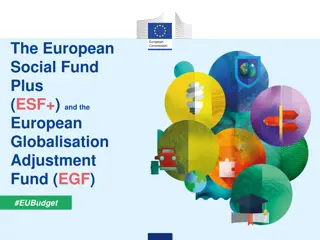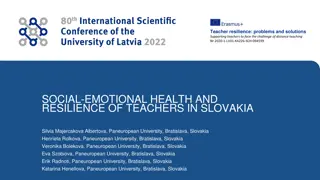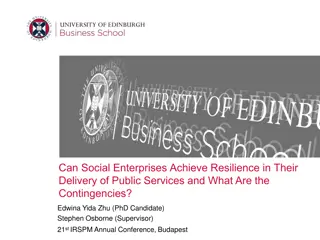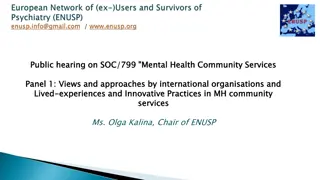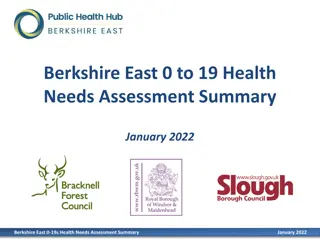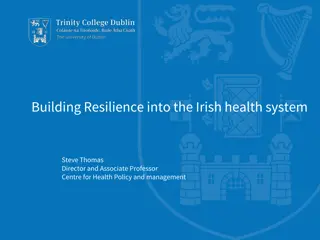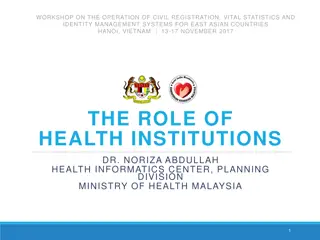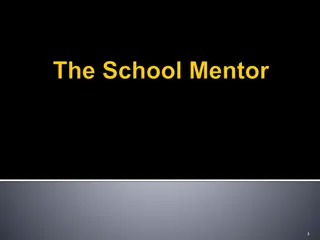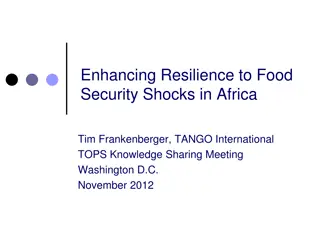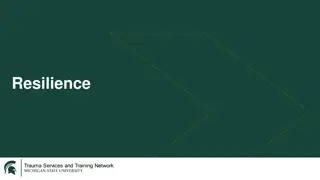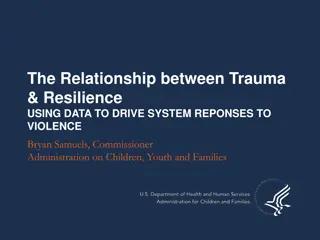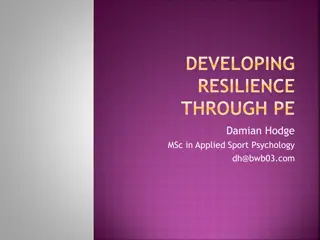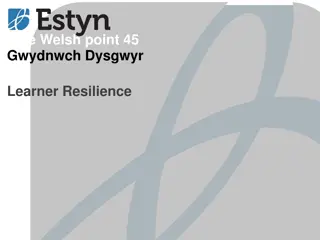Social Emotional Health and Resilience of Teachers in East European Countries
Research conducted as part of an ERASMUS+ project aimed to assess the social-emotional health and resilience of teachers in Latvia, Lithuania, and Slovakia post-pandemic. The study focused on examining the level of teacher covitality, psychological indicators, and resilience using specific measures. The outcomes aimed to identify areas requiring support and development for teachers in the mentioned countries. The research involved 1200 teachers from elementary to high schools, providing valuable insights into the mental health challenges faced by educators in the region.
Download Presentation

Please find below an Image/Link to download the presentation.
The content on the website is provided AS IS for your information and personal use only. It may not be sold, licensed, or shared on other websites without obtaining consent from the author. Download presentation by click this link. If you encounter any issues during the download, it is possible that the publisher has removed the file from their server.
E N D
Presentation Transcript
Skolotju dzvesspka un socili emocion l s vesel bas r d t ju saist bu p t jums Latvij , Slov kij un Lietuv Gajdo ov , E.,Ala Petrulyt , A., Svence, G. (2022).Social Emotional Health and Resilience of Teachers in the East European Countries. Human, Technologies and Quality of Education, 2022 : proceedings of scientific papers = Cilv ks, tehnolo ijas un izgl t bas kvalit te, 2022: rakstu kr jums. Place of publication: Riga. Publisher: Latvijas Universit te. Editor: Daniela, L.. ISBN (Electronic): 978-9934-18-911-1. DOIs: https://doi.org/10.22364/htqe.2022 URLs: https://www.apgads.lu.lv/fileadmin/user_upload/lu_portal/apgads/PDF/HTQE- 2022/HTQE-2022.pdf Guna Svence, VPUPK docenta p.i.
Structure of presentation Introduction Primary research aim Questions of research Theoretical background Measures SEHS-T and RS Methodology Sample
Introduction of topic Research on mental health and resilience of teachers from Latvia, Lithuania and Slovak Republic was conducted as part of the ERASMUS+ project Supporting teachers to face the challenge of distance learning . The primary goal of the first project phase to assess social emotional health, so-called Covitality and resilience of teachers in elementary, secondary and high schools in post pandemic times and to focus on those areas which require significant support and development. 1200 teachers, 400 from each participating country, took part in the research.
Research aims and objectives Primary research aim was to examine level of teacher covitality, covitality domains and psychological indicators in the context of resilience in three East-European countries (Latvia, Lithuania, Slovakia) in the pandemic period which often have negatively affected mental health and coping in everyday life. Methods Social- emotional Health Survey - Teachers (SEHS-T, Furlong & Gajdo ov , 2018) and Resilience Scale RS (Wagniled & Young, 1993, Wagnild, 2016) were used as measures for data collection. We formulate the research objectives: To evaluate level of social-emotional health domains and indicators (SEHS-T) of teachers in Latvia, Lithuania, Slovak Republic and whole sample To evaluate teachers resilience (RS - 14) in Latvia, Lithuania, Slovak Republic and whole sample To identify correlations between SEHS-T and RS-14 of teachers sample.
Research main questions were formulated 1. What is the overall level of social emotional health (SEHS-T) of teachers in Latvia, Lithuania and Slovakia? 2. What is the level of teachers resilience in Latvia, Lithuania and Slovakia? 3. How do the SEHS-T and RS dimensions and their correlations demonstrate a potential problem in the context of the socio-emotional health on a sample of teachers?
Theoretical background,1 The Covid-19 crisis and the associated distance learning process have led to increased Teachers Social-Emotional Health and Resilience in Covid-19 Crisis: psycho-emotional stress, which has the potential to lead to a deterioration in teachers psycho-emotional health and quality of life (UNESCO, 2020; Svence et al., 2021; Lagzdi a, 2021). Emergency remote teaching differs from correspondence education with its related difficulties because face-to-face educational institutions are mostly not ready to provide suitable infrastructure for online teaching, and teachers lack information and experience to teach by distance (Zhang, 2020, as mentioned in Carrillo & Flores, 2020) Under the present circumstances, it is accompanied with the stress of necessity to apply new teaching methods, rework all teaching aids and materials, and learn new online communication methods and master IT technologies. It also means that it is not possible to develop targeted and in needs-based teachers resilience-building and emotional support programs although they are so much needed under the current circumstances (Fokkens-Bruinsma et al., 2020).
Theoretical background,2 The research is based on the concepts of social-emotional health (Furlong et al., 2017; Furlong et al., 2014; Furlong & Gajdo ov , 2018, as mentioned in Lapi a, 2021) and resilience (Wagnild & Young, 1993; Wagnild, 2009; Wagnild, 2016). These concepts are closely related to other concepts in psychology, especially health psychology, such as psychoemotional health. In turn, all these concepts are generally supported by the bio-psycho- emotional health model. The study uses several keywords included in the bio-psycho-social model and adapted in Social- Emotional Health Survey Teachers SEHS-T (Furlong et al., 2017; Furlong et al., 2014; Furlong & Gajdo ov , 2018, as mentioned in Lapi a, 2021): social support (SEHS-T), interpersonal relationships (SEHS-T), socio-economic status (demographic issues), physical activity adapted in Resilience Scale RS 25 (Wagnild & Young, 1993; Wagnild, 2009; Wagnild,2016) (RS), emotions (SEHS-T), self-esteem, attitudes towards self (RS), faith or individual belief system (SEHS-T, RS), and stress management (SEHS-T and-RS).
Theoretical background,3 Another study conducted in 2014 defined social-emotional health as the ability to regulate emotions, such as the ability to regulate and control one s emotions, and emotional intelligence, which is the ability to recognize emotions and use them constructively. The study noted that social-emotional health is a multidimensional construct that incorporates positive mental health structures such as life satisfaction (Snowden et al., 2015). In 2014, Michael Furlong and his team developed a Social-Emotional Health Survey (SEHS). This survey allows the measurement of four constructs that make up social-emotional health (SEH) and the total SEH factor (Boman et al., 2020). The basic principle of SEHS is related to the assumption that an individual s sense of psychological prosperity is partly based on living conditions that promote the disposition of internal cognition or form individual schemes. These schemes are related to an individual s beliefs about themselves, others, emotional competencies, and viability (Furlong et al., 2014).
What Does the SEHS-S Measure? The aim of the Social Emotional Health Model by Furlong is to identify key positive indicators for prediction of mental health (Furlong et al., 2014). It is based on positive psychology, consists of 4 positive main domains and 12 subscales as psychological indicators of mental health. The Belief in self domain consists of Self-Efficacy, Persistence and Self-Awareness. The Belief in Others domain comprises Family Support, Institutional Support and Colleague Support. Emotional Reappraisal, Empathy, Self-Regulation, and the last domain, Competences consists of Cognitive Engaged Living, includes Gratitude, Zest and Optimism. The overall Social Emotional Health is referred to as Covitality.
What is Resilience? Many authors have defined resilience (Rutter,1987; Wagnild, 2014). While these definitions have some differences, there are fundamental similarities among them, including adaptation, balance, competence, determination, optimism and acceptance (Wagnild, 2014, s.11). Wagnild and Young (1993) wrote that resilience is a personality characteristic that moderates the negative effects of stress and promotes adaptation. Wagnild (2014, p.10) stressed that our own research has shown that resilience protects against (and reverses) depression, anxiety, fear, helplessness, and other negative emotions, and thus has the potential to reduce their associated physiological effects . Resilience has also demonstrated potential to positively affect health, life satisfaction, quality of life and to prevent of the onset of depression (MacLeod et al., 2016). This may be considered a very important characteristic in teachers who in the present perform their profession in highly stressful and unfovorable circumstances in a relatively long-lasting pandemic period.
Resilience According to Ungar (2010) in the process of resilience development it is desirable to support the individual ability to direct approach to health- sustaining resources, including opportunities for well-being and positive family, community and cultural interactions in culturally meaningful ways. Currently resilience will be discussed as a dispositional characteristic of teacher personality which enables to identify the current level of adaptation to adversity in the personality environment system and which is considered a prerequisite for effective future adaptations.
Methodology Instrumentary- SEHS-T The Social-Emotional Health Survey Teachers (SEHS-T) methodology was adapted in these countries in April 2021. Teachers reliability of SEHS-T and its domains in Slovak Republic and Latvia Cronbach s Alpha N statements Slovak Latvia In Slovakia the adaptation of SEHS-T was performed by Eva Gajdosova and Veronika Bisaki with 91 participants teachers from the primary and secondary schools, in Latvia the adaptation of SEHS-T was performed by Guna Svence and the research assistant L smaLagzdi a with 50 participanting teachers according to the procedure adopted as a standard in psychology and described in Psychology - International Test Commi.ssion (2010) and Republic 0.930 0.813 0.818 0.814 0.845 SEHS-T 48 BIS 12 BIO 12 EC 12 EL 12 0.890 0.870 0.820 0.720 0.770 in Lithuania the SEHS-T adaptation was done by Ala Petrulyt with 142 teachers.
Methodology Instrumentary- RS Resilience Scale (RS; Wagnild & Young, 1993, 2016) is a measure for assessment of individual resilience in two dimensions: personal competence and acceptance of self. It consists of 25 items which are rated on a Likert- type scale from 1-7. Resilience Scale RS scores range from 25 to 175. Scores greater than 145 indicate moderately high and high resilience, scores from 116 to 144 indicate moderately low to moderate levels of resilience, and scores of 115 and below indicate low resilience (Wagnild, 2016, p. 82). Resilience Scale RS-25 was used separately in Latvian sample and in Slovak sample. Resilience short version-Scale RS-14 scores from 14 to 98. Scores greater than 82 indicate moderately high and high level of resilience, scores from 65 to 81 indicate moderately low to moderate resilience, and scores of 64 and below indicate low resilience. Short version RS-14 was used in the whole sample. RS has demonstrated very good validity and reliability which were repeatedly confirmed with various age and professional samples (Ahern et al., 2006; Wagnild, 2009). Results of several studies showed that RS demonstrated stability over time: test-retest reliability within 3 months was r= .90 (Portzky, Wagnild, et al., 2010). Series of correlational and regression analyses were conducted using confirmatory factor analysis to assess factor structure of the RS (Wagnild & Young, 1993) at the Department of Psychology, Faculty of Arts, Comenius University in Bratislava (Mesaro ov , Hajd k, Heretik, 2014). RS shows good psychometric properties including acceptable reliability (Cronbach Alpha=0.818).
Participants The research sample includes 1200 participants teachers, 400 teachers from every participating country Latvia, Lithuania, Slovak Republic. 3 selection criteria for recruitment of 400 teachers from each of these 3 countries were used: 1) targeted partner schools with which there have been other forms of co-operation. Principals were directly approached based on trust and confidence that the majority of teachers will take part in the survey. The partner schools were divided according to the second principle. Descriptive analysis shows, that 1054 (87. 8%) female teachers and 146 (12.2%) male teachers participated in the research. In Latvia there were 96.5% female teachers, in Lithuania 77.3% female teachers and in Slovak Republic 89.8% female teachers. 79 (6.6%) of teachers were 30 years old and younger, 242 (20.2%) teachers 31 40 years old, 389 (32.4%) teachers 41-50 years old, 366 (30.5%) teachers 51-60 years old and 124 (10.3%) teachers 61 years and older. 2) educational institutions of different sectors (standard primary and secondary schools, high schools - arts and crafts, technical schools, countryside and city schools, small schools and large schools, state) 3) principle of random sampling is chosen. The research sample confirmed the prevalence of female teachers and teachers older than 40 years in all 3 countries.
Social Emotional Health Survey-Teachers (SEHS-T; Furlong & Gajdo ov , 2018) is a modified version of the Social-Emotional Health Survey Higher Education (SEHS-HE; Furlong et al., 2017). It has been modified in 6 items with the agreement of its author Furlong for the assessment of teacher social-emotional health. The SEHS-T measures the covitality latent trait. Covitality refers to the co-occurrence of positive, healthy traits. It embodies the synergistic effects of positive mental health resulting from the interplay among multiple positive-psychological building blocks (Furlong et al. 2014a, p. 3).
Data Analysis Data were analysed using the IBM SPSS 21.The internal consistency of questionnaires was verified using Cronbach s alpha coefficient. Subsequently, parametric analysis of variance (ANOVA), Student t-test and non-parametric Kruskal- Wallis and Mann-Whitney U test were conducted. Substansive significance of differences was assessed based on 2..Histograms were used to show normality. The correlations between the variables were examined using the Spearman correlation coefficient.
Some results, 1. Covitality Average score of overall covitality level in teachers from Latvia, Lithuania and Slovakia is M=230.34 (theoretical score range: 48-288, empirical range: 69-288, SD 24.89, minimum 69.00, maximum 288.00), what indicates high covitality level. The highest score was found for Slovak Republic teachers (M=238.65), teachers from Lithuania (M= 230.51) and Latvia (M= 221.54) scores slightly lowed. There is significance of differences among countries, with medium eta squared/effect size (p 0,001, 2 = .09
Results, 2. Teacher SEHS-T domains BIS, BIO, EC, EL in Slovak Republic, Latvia, Lithuania . Belief-in-self (BIS) BIS in teachers in participating countries is at high level (M=57.11). The highest level was found in Slovak Republic teachers (M=59.65), only slightly lower level of BIS was found in Lithuania teachers (M=58.53) and lower level, however still in the high range, was found in Latvia teachers (M=53.16)
Results, 2. Teacher SEHS-T domains BIS, BIO, EC, EL in Slovak Republic, Latvia, Lithuania . Belief-in-others (BIO) Differences in Belief-in-others (BIO) among the countries are statistically significant with medium effect size (p 0,001, 2 = .07). The average overall score in BIO is the lowest compared to other covitality domains (M=56.83). Comparative analysis revealed that Lithuanian (M=55.32) and Latvian (M=55.67) teachers scored in this domain lowed than Slovak Republic teachers (M=59.32) While the differences between Slovak Republic and Lithuania (p 0,001) and Slovak Republic and Latvia (p 0,001), are statistically significant, there is no significant difference between Lithuania and Latvia in BIO (p= .082, 2 = .246).
Results, 2. Teacher SEHS-T domains BIS, BIO, EC, EL in Slovak Republic, Latvia, Lithuania . Emotional Competence (EC) Repeatedly Slovak teachers showed higher level of EC compared to the teachers from the other two countries (M=60.66). However only slightly lower level of EC was found in Latvian teachers (M=58,35) and Lithuanian teachers (M=57.10) respectively. Differences among the countries in the domain EC are statistically significant (p 0,001, 2 = .06), between Slovak Republic and Lithuania (p 0,001), Slovak Republic and Latvia (p 0,001) as well as between Lithuania and Latvia however at p= .002, 2 = .007).
Results, 2. Teacher SEHS-T domains BIS, BIO, EC, EL in Slovak Republic, Latvia, Lithuania . Engaged Living (EL) The average score in the domain EL is M=57.59. Differences between the countries are statistically significant (p= .001, 2 = .04). Lower score was found for Lithuanian teachers (M= 55.91), followed by Latvian teachers (M=57.95) while Slovak Republic teachers scored higher (M=58.84). While there is a statistically significant difference between Lithuania and Latvia (p 0,001) and Lithuania and Slovak Republic (p 0,001) in EL, between Slovak Republic and Latvia no statistically significant difference was found (p= .134, 2 = .401).
Results 3. Overall level of resilience and its dimensions in Lithuanian, Latvian and Slovak Republic teachers Results confirmed that participants scored at moderate level in resilience (M=76.30), i.e. Lithuanian (M=72.93), Latvian (M=75.04) and Slovak Republic (M=80.92) teachers reported only moderate level of resilience. There are however significant differences in resilience among the countries (p 0,001, 2 = .10). Similar differences were found for both resilience dimensions, Personal Competence (p 0,001, 2 = .99) and Acceptance of Self and Life (p .001, 2 = .13).
SEHS-T Covitality Resilience RS 14 Correlation Coefficient ,679** ,000 ,579** ,000 ,528** ,000 ,580** ,000 ,615** ,000 ,539** ,000 ,441** ,000 ,503** ,000 ,400** ,000 ,457** ,000 ,412** ,000 ,452** ,000 ,451** ,000 ,418** ,000 ,426** ,000 ,542** ,000 ,528** Sig. (2-tailed) Correlation Coefficient Belief-in-Self domain 1 Sig. (2-tailed) Correlation Coefficient Belief-in-Others domain 2 Sig. (2-tailed) Correlation Coefficient Emotional Competence domain 3 Sig. (2-tailed) Correlation Coefficient Engaged Living domain 4 Sig. (2-tailed) Correlation Coefficient Self-Efficacy Sig. (2-tailed) Correlation Coefficient Persistence Sig. (2-tailed) Correlation Coefficient Self-Awareness Sig. (2-tailed) Correlation Coefficient Family Support Sig. (2-tailed) Correlation Coefficient Institutional Support Sig. (2-tailed) Correlation Coefficient Collegaue Support Sig. (2-tailed) Correlation Coefficient Cognitive Reappraisal Sig. (2-tailed) Correlation Coefficient Empathy Sig. (2-tailed) Correlation Coefficient Self-Regulation Sig. (2-tailed) Correlation Coefficient Gratitude Sig. (2-tailed) Correlation Coefficient Zest Sig. (2-tailed) Correlation Coefficient Optimism
Discussion Results indicate that especially Emotional Competence (EC) and Engaged Living (EL) are associated with resilience. The international research in the East-European countries Latvia, Lithuania aand Slovak Republic has confirmed that the level of socio-emotional health of teachers is high, both overall and in its key domains. The overall resilience of teachers was found to be between high and moderate level, the same applied to individual resilience dimensions. The teachers' socio-emotional health was positively correlated with resilience. The correlations between covitality and its key domains and resilience are on very high level, especially the EL Engaged living of teachers which is the most important predictor of mental health of teachers in schools. Also self-efficacy, cognitive reappraisal, zest and optimism were highly positively correlated with resilience. Findings on associations between social-emotional health indicators and resilience confirmed that there are several psychological constructs associated with resilience. Teachers, in the process of coping, use various internal and external resources to overcome adversity. Important protective factors on individual level are self- esteem, positive self-concept and high self-efficacy (Everall, Altrows, Paulson, 2006; Fergus, Zimmerman, 2005). Self-esteem which is positively associated with resilience and personality (Mes ro ov et al., 2014; Hayter & Dorstyn, 2014), is also positively associated with an active process of coping (Daigneault et al., 2013, Arslan, 2016) and engagement in family and community environment (Dumont & Provost, 1999).
References Gajdo ov , E., Ala Petrulyt , A., Svence, G. (2022).Social Emotional Health and Resilience of Teachers in the East European Countries. Human, Technologies and Quality of Education, 2022 : proceedings of scientific papers = Cilv ks, tehnolo ijas un izgl t bas kvalit te, 2022: rakstu kr jums. Place of publication: Riga. Publisher: Latvijas Universit te. Editor: Daniela, L.. ISBN (Electronic): 978-9934-18-911-1. DOIs: https://doi.org/10.22364/htqe.2022 URLs: https://www.apgads.lu.lv/fileadmin/user_upload/lu_portal/apgads/PDF/HTQE-2022/HTQE-2022.pdf Svence, G., Bri ka, I. (2022). Teachers Social-Emotional Health and Resilience in Covid-19 Crisis: Latvian Sample. Human, Technologies and Quality of Education, 2022 : proceedings of scientific papers = Cilv ks, tehnolo ijas un izgl t bas kvalit te, 2022 : rakstu kr jums. Place of publication: R ga. Publisher: Latvijas Universit te. Editor: Daniela, L. ISBN (Electronic): 978-9934-18-911-1. Electronic versions: Teachers Social-Emotional Health and Resilience in Covid-19 Crisis. DOIs: https://doi.org/10.22364/htqe.2022
Paldies ar uzmanbu! Guna.Svence@rsu.lv
